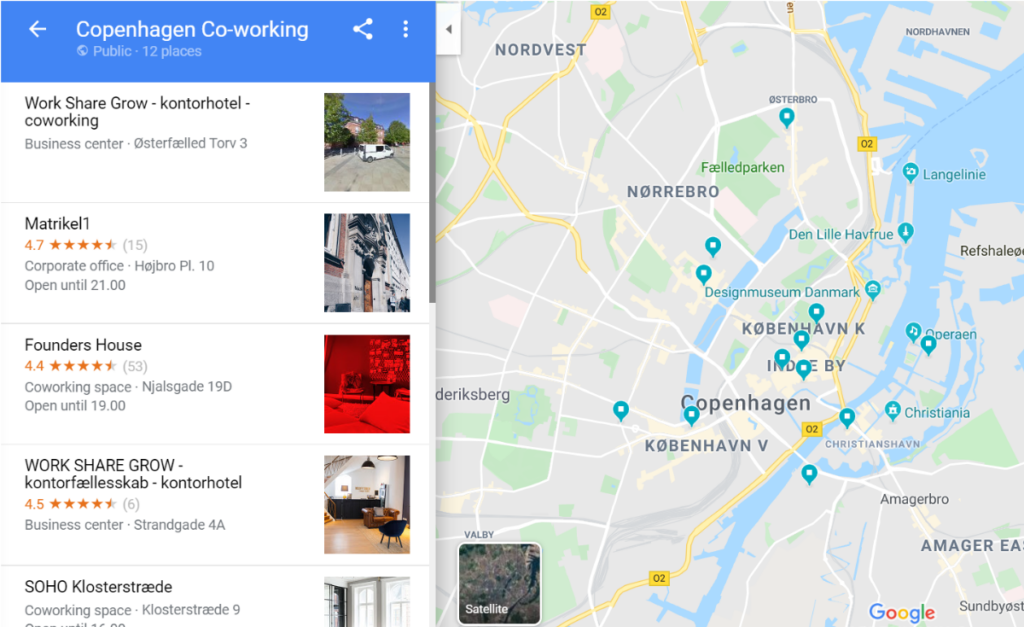My main task this week was to stop working from home.
Since moving to our apartment I’ve taken to doing “laptop stuff” (it might be a stretch to call it work at the moment) from either the living room table, or one of the many excellent libraries in the city.
Both are good for getting silent work done, however not so good in terms of having “that office feel” of socialising with colleagues.
With Project Danish Admin almost over, I’m beginning to think more about the next phase (Project Making Friends In Denmark) and finding a social place to work plays a big part in that.
As such, I set about finding a co-working space on Tuesday morning.
Doing the research
Pretty simple really. The concept of a “co-working space” has been created for pretty much the exact situation I find myself in: self-employed people who want the social interaction that comes with working around others.
I Googled for the best co-working spaces in Copenhagen and a few blog posts had been written giving a Top 10, which got the process started.
After that, I typed in “co-working space” to Google Maps which brought up some that hadn’t appeared.
I browsed through the About page to get a sense of the place and then added the location to a list on Google Maps:

Once I had a decent number I planned a cycle route that afternoon to go and visit as many as possible.
I’d go to the reception, say I was looking for a new place to work and then someone would show me around.
This is where the differences began to show in the many types of “co-working space”.
The glorified café
These were set up for “creatives” who wanted somewhere reliable to work from.
The membership option gave access to the café area where you could come each day, find a seat (usually a stool/ hard wooden chair) and use the Wifi.
The main value proposition appeared to be somewhere where you always get a seat and won’t be passive aggressively asked you if you want another coffee.
As they were appealing to e.g. graphic designers/ early stage startup founders they were the most affordable.
Examples: Nomad Workspace (community space), Dare2Mansion, Republikken (community space)
The trendy company offices
These often referred to themselves as an “office hotel”.
These were pretty fancy and were occupied by smartly dressed professionals. The sense was that people here were old enough to have “made it” to some degree, and as such wanted to spend their working hours somewhere comfortable.
They would also house larger companies (~20 people) who wanted to have a nice place for their company to be.
The options for a “flex desk” felt like a bit of an afterthought.
Examples: SOHO, Work Share Grow, Dayhub
The start-up hubs
These were aimed at predominantly new tech companies.
The ethos and communication were all about finding a community of like-minded people also on the struggle of building a startup.
Here the value proposition was around the community (social breakfasts, workgroups, networking events) as well as all of the usual things about fast Wifi and free coffee.
Examples: Talent Garden, Republikken (membership), Founders House
The communes
The final category of workspace is almost familial.
Often described as “house” they really felt like entering a home. The person who answered the buzzer clearly wasn’t used to visitors but nevertheless was happy to show me around.
There would be 20-30 people in the house (often each company in a converted bedroom) and it felt like a close-knit community. There weren’t the open plans of the hubs, it was all quite close.
The residents of the house usually shared a common area of interest in their work (environmental issues; gaming) and, naturally, knew a lot about what each person was doing.
Joining one of these houses would definitely lead to a sense of belonging within a community, though it required conforming to the ethos of the group, and felt like a commitment to clan.
Examples: Spilhuset (“The Play House”); Greencubator
What are the important factors?
Going out and speaking with the different spaces brought out a few factors which came to be important:
- Seating set up: I realised I’m not down for sitting on a hard wooden chair
- Sense of community: how much other self-employed people interacted, and what was the support
- Group lunches: most larger places provided lunch (~£8) that was eaten together by the whole workspace. They all looked phenomenal
- Commute time: I realised I’m willing to cycle an extra 5 minutes to go somewhere good
- Cost: most were +/- 25% of DKK 1,800 + VAT (£260)/ month for a “flex desk” (you come each day but can’t leave your stuff overnight)
My feeling is that I’ll go for somewhere closer to the start-up hub set up, mainly because other people will be doing the same thing as I am, and it’ll be legit to start conversations with people (as opposed to people there doing an office job).
There are still some places I’m going to check out but should hopefully get it sorted in the next week or so.
My aim, for now, is to find a place to start in January, but also to still go along to the Christmas Party…
In other news…
I’m approaching the end of my first round of Danish classes. My new favourite words are those for step-child (-barn) or step-Dad (-far).
In both, the Danish for step- is bonus-.
This means when a child talks about their Mum’s new partner they refer to him as their “Bonus Dad”.
This post originally featured in the newsletter I write. If you’d like to sign up to receive it at the start of each month, you can do so below: